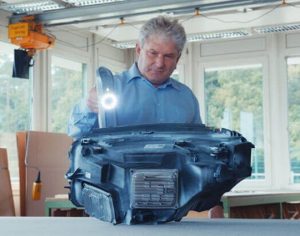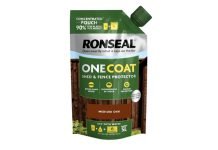
Industrial packaging must be strong, which is why the heavy-duty corrugated board doesn’t immediately spring to mind as the perfect solution. But for many packaging challenges, it can save time, money, and resources.
For automotive components, chemicals, DIY products, household appliances, and sporting goods the list of industries and manufacturers that need to package and ship their products reliably and efficiently is virtually endless. This is not by any means a trivial challenge, especially when import regulations or other issues in production and logistics or distribution bring additional complexity. Such issues usually include shipping, storage, safety, or the simple matter of handling packaging on site. At the same time, companies need to consider their own CO2 footprint and overall sustainability, which is an area many companies struggle with.

Photo Mondi
With those challenges in mind, a high-performance and reliable alternative to wood or metal are heavy-duty corrugated board, as industrial packaging for heavy loads. Weighing up to 80% less than wood or metal industrial packaging, it undergoes a broad range of tests during development, oriented to a broad range of anticipated conditions – drop tests in the lab, climate chambers, and comprehensive shipping simulations for a wide range of conditions. Most heavy-duty corrugated board solutions are better than more rigid types of packaging in absorbing shocks and vibration during transportation. And the heavy-duty corrugated board can withstand demanding conditions such as heat or humidity. Especially when shipped by sea, contents are exposed to high ambient humidity and high condensation, often for several weeks. All of Mondi’s heavy-duty corrugated board grades are therefore bonded based on wet-strength parameters and are made using high-quality papers for durability across different climatic regions.
“Many of its customers are visibly impressed when they learn that heavy-duty corrugated packaging can bear loads of over a tonne and that even in hot and humid climate zones, corrugated boxes are highly reliable for shipping heavy items. Switching to a lightweight, paper-based, recyclable packaging material can of course also help manufacturers achieve their own sustainability goals. Mondi’s FSC-certified paper-based packaging can do precisely that,” Gerald Dörzbach, Sales director, Mondi Corrugated Solutions
With the heavy-duty corrugated boards, various import restrictions do not apply–import restrictions relating to wooden containers, for example, which can sometimes be a source of problems. And since the corrugated board is a recyclable single-journey solution, it does not have to be shipped all the way back empty, which is often the case with wooden or metal packaging. Moreover, it is easy to fold and compact on site in preparation for recycling. Corrugated board’s current status as the most frequently recycled packaging material, Europe and other regions have extensive, advanced recycling infrastructure for recycling it. Heavy-duty corrugated board is also designed to maximize the efficient utilization of shipping and storage space.
In a recent case study, the corrugated solution developed by Mondi for brake boosters for Volvo Cars enabled 18 units to be packed instead of the previous twelve, with the same packing volume, i.e. a 50% increase in packing density using almost the same amount of material. Overall, based on the total number of components shipped, a 33% reduction in the number of raw materials and the amount of shipping and storage space required was achieved.
Time is money when it comes to packaging
Another key aspect of this type of packaging is the question of labor costs for handling. Since the heavy-duty corrugated board is foldable, after delivery it occupies less space than metal or wooden packaging, which is usually delivered ‘as is’ without any reduction in its volume. The time and labor required to erect the packaging then have to be taken into account. No company wants its highly-trained specialist employees spending valuable time assembling corrugated packaging – bearing in mind that metal or wood packaging brings various injury risks in the form of metal swarfs or wooden splinters and lifting hazards.
How to successfully tackle this issue of handling costs is evident from a recent case study. For a manufacturer of electric motors and fans, Mondi developed a dual-component stacking corner packaging solution for axial fans that requires 48% less time to erect than the previous solution. The total time savings was a remarkable 17 hours for every 1,000 fans packed. To further improve handling efficiency and minimize material usage, the new stacking corners were made from a single piece of corrugated board, which reduced material usage by 30%.
From enquiry to custom packaging in a few working days

Photo Mondi
Although many products are unique in their shape, size, and handling requirements, usually it takes only 10 to 14 working days to develop a custom packaging solution. Once all the specifications are known, in particular the size dimensions, load requirements, and customer’s production and distribution specifics, the development team generates a 3D simulation of the packaging and provides all the relevant data. Further adjustments are then made, and the first full-sized samples are constructed using a cutting plotter. Digital drawings used as the basis for the quote are then made available.
Customizing in this way eliminates the problem of packaging that is too large, too expensive, too cumbersome, or too time-consuming.
“It’s important to think beyond just the price of the packaging. Custom packaging solutions may be more expensive initially, but over the long term, there are cost savings in many areas. That’s because the cost factors for packaging include warehousing, shipping, and downtime due to damage caused by improper packaging. You have to look at the entire value chain of the product to get a true picture of the packaging price,” Jürgen Schmidt, head of Product Development, Mondi Corrugated Packaging.
Alternative to plastic IBCs
Standard packaging, rather than the customization approach, can also be a very successful choice. Mondi’s easy-pak and pak-(k)it packaging solutions, for example, are deliverable immediately, without having to earmark the aforementioned number of days for customization. Designed for large, bulky, heavy goods, they can be quickly erected by a single person, save space, and come in a comprehensive range of sizes for products of all kinds. Pre-assembled kit solutions are ideal for smooth intralogistics.
For the chemicals industry, the Octabin solution Kem-Pak or Tanker Box is highly suitable. The former is a chemicals container that is ideal for granulates, powders, or similar substances, can easily hold up to 1,000 kilograms, and has an adapted octagonal shape that prevents bulging during filling. A tanker Box is a corrugated cardboard box that can be used instead of an IBC container (dimensionally stable plastic). Tanker Box has an integrated food-safe PE bag for foodstuffs such as fruit juice or edible oil.
The range of possible applications for heavy-duty corrugated cardboard packaging is very broad – well suited to virtually any company – and the paper-based approach is definitely worth considering as an alternative to conventional boxes or containers.










